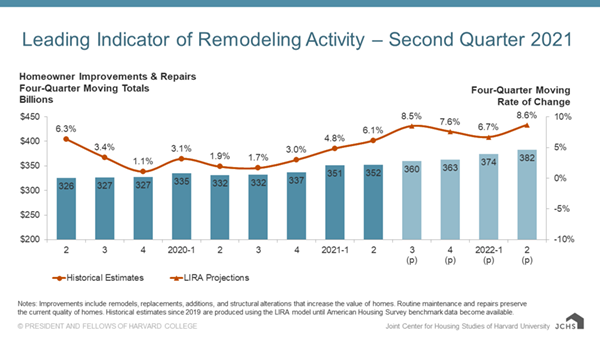Further Strengthening Expected for Home Remodeling

CAMBRIDGE, MA – Annual gains in homeowner improvement and maintenance spending are set to accelerate in the second half of the year and remain elevated through mid-year 2022, according to the Leading Indicator of Remodeling Activity (LIRA) released today by the Remodeling Futures Program at the Joint Center for Housing Studies of Harvard University. The LIRA projects annual growth in home renovation and repair expenditures will reach 8.6 percent by the second quarter of next year.
“Home remodeling will likely grow at a faster pace given the ongoing strength of home sales, house price appreciation, and new residential construction activity,” says Chris Herbert, Managing Director of the Joint Center for Housing Studies. “A significant rise in permits for home improvements also indicates that owners are continuing to invest in bigger discretionary and replacement projects.”
“Larger gains in retail sales of building materials suggest the remodeling market continues to be lifted by DIY activity as well,” says Abbe Will, Associate Project Director in the Remodeling Futures Program at the Center. “By the middle of next year, annual remodeling expenditures to owner-occupied homes are expected to surpass $380 billion.”
A year after the unprecedented changes to the US economy brought on by the pandemic, many economic indicators are showing extreme percent changes from pandemic-induced lows. To reduce the immense growth rate volatility generated by these year-over-year comparisons, the projection for 2022-Q2 utilizes smoothed data for two leading model inputs: residential remodeling permits and single-family housing starts. Using unsmoothed inputs in the LIRA model would have projected an unlikely annual growth rate roughly twice as large as reported. The Remodeling Futures Program will continue to monitor input volatility.
Click image for full-size chart.
The Leading Indicator of Remodeling Activity (LIRA) provides a short-term outlook of national home improvement and repair spending to owner-occupied homes. The indicator, measured as an annual rate-of-change of its components, is designed to project the annual rate of change in spending for the current quarter and subsequent four quarters, and is intended to help identify future turning points in the business cycle of the home improvement and repair industry. Originally developed in 2007, the LIRA was re-benchmarked in April 2016 to a broader market measure based on the biennial American Housing Survey.
The LIRA is released by the Remodeling Futures Program at the Joint Center for Housing Studies of Harvard University in the third week after each quarter’s closing. The next LIRA release date is October 21, 2021.
The Remodeling Futures Program, initiated by the Joint Center for Housing Studies in 1995, is a comprehensive study of the factors influencing the growth and changing characteristics of housing renovation and repair activity in the United States. The Program seeks to produce a better understanding of the home improvement industry and its relationship to the broader residential construction industry.
The Harvard Joint Center for Housing Studies advances understanding of housing issues and informs policy. Through its research, education, and public outreach programs, the Center helps leaders in government, business, and the civic sectors make decisions that effectively address the needs of cities and communities. Through graduate and executive courses, as well as fellowships and internship opportunities, the Center also trains and inspires the next generation of housing leaders.
Contact: Kerry Donahue, (617) 495-7640, [email protected]

